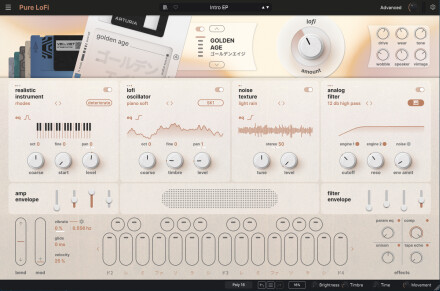Every year, it's a bit of a ritual: Arturia delivers a new V Collection. This eleventh edition continues the trend begun in recent years, going beyond the simple modeling of vintage instruments. What's in it for us?

Launched in 2007 with a bundle featuring seven modeled synthesizers, the V Collection has evolved considerably with each update, gradually broadening its scope.
First focused on modeling vintage synthesizers, it then integrated keyboards (acoustic and electric pianos, organs, clavinet), samplers and, more recently, sample-based sound modules with the Augmented series.
The “V” in the name initially seemed to refer to “vintage”, but it’s now taken for granted that it stands for “virtual”.
This eleventh version introduces three new instruments: a model of the Roland JP-8000 christened Jup-8000 V, a novel instrument named Pure Lo-Fi, as well as Augmented Mallets.
There’s also a complete rewrite of SEM V, as well as the integration of MiniBrute V, Synthx V) and Augmented Yangtze, the latter three having appeared earlier in the year.
Also, all Augmented series instruments are upgraded to version 2, and the MiniFreak V also benefits from an update.
Over the past few years, the V Collection has established itself as a must-have in the field of virtual instruments, with 45 instruments now included. Aware that this wealth of instruments doesn’t meet everyone’s needs, Arturia now offers two editions: the V Collection Pro, which includes all the instruments as in previous versions, and the brand-new V Collection Intro, which features ten instruments carefully selected for their coherence, to provide an entry ticket that’s both accessible and versatile.
As usual with Arturia, installation and authorization are via the Arturia Software Center, and the comprehensive PDF user manuals for each instrument are available in several languages.
Let’s take a closer look at the main new features.
Jup-8000 V : a virtual look back at an iconic synth from the '90s
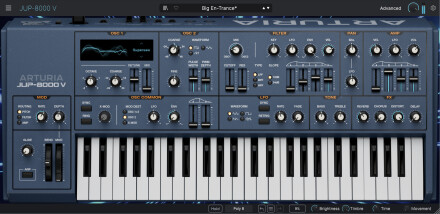
But this wasn’t the case: the JP-8000 (and its desktop version, the JP-8080) established itself with a character all its own: more digital than analog, but with that typical flavor of the first VA synths of the 90s. The JP-8000 built its reputation by becoming a cornerstone of dance, techno and trance in the second half of the '90s and early 2000s. So it’s easy to understand why the Jup-8000 V has been included, and its sounds are likely to bring back many memories for those who knew that era.
The construction of a sound begins with two oscillators, the first of which has its own particularities and contributes strongly to the sound and possibilities of the Jup-8000 V. In addition to the classic Triangle, Sawtooth, Square, and Noise, the Supersaw, Triangle Mod, and Feedback Oscillator waveforms are also available—seven in all. Each waveform has two separate settings for sculpting.
.

- 01 – Jup-8000 V – Seq100:36
- 02 – Jup-8000 V – Eurobass01:28
- 03 – Jup-8000 V – Pad Exct01:10
- 04 – Jup-8000 V – Pad Orbit02:43
- 05 – Jup-8000 V – Trancebass00:51
- 06 – Jup-8000 V – Trancekick00:33
- 07 – Jup-8000 V – Tranceloop01:23
- 08 – Jup-8000 V – Trancestb00:33
It’s impossible to talk about the JP-8000 without mentioning the Supersaw, the synth’s true signature sound. This wave combines seven sawtooths that can be mixed and detuned. With this alone, it’s easy to recapture the timbre of typical 90s trance leads. This waveform is also an excellent starting point for designing dense, broad layers.
The Triangle Mod, on the other hand, is a triangular waveform that can be harmonically enriched up to very metallic timbres. The Feedback Oscillator, another of the JP-8000's signature sounds, is a sawtooth signal to which feedback is applied, and is useful for creating synchro-like tones. It can produce very aggressive sounds, even to the point of evoking feedback.
It’s worth noting that the Noise has its own filter circuit, totally independent of the main section.
The second oscillator, for its part, is more conventional, offering the classic triangle, sawtooth, and square waveforms, with, here too, an adjustable and modulable pulse width.
The “OSC Common” section manages interaction between the two oscillators, enabling synchronization, ring modulation, or even cross modulation (X-Mod), with additional routing to a dedicated LFO or AD envelope.
Once mixed, the two oscillators feed a resonant multimode filter (LP/HP/BP) whose slope can be selected between 12 or 24 dB/octave. Arturia has perfectly restored the sonic character of this filter, faithfully restoring the distinctive grain of the '90s and a sometimes slightly aggressive resonance.
On the modulation side, two additional ADSR envelopes are offered: one associated with the filter, the other with the amplifier, complemented by two LFOs. Each synthesizer section benefits from direct access to the first LFO, while the second is assigned to the modulation wheel.
At the end of the chain, the signal passes through a small 2-band equalizer (Bass/Treble), handy for adjusting sounds that are intrusive in a mix.
Compared with the original JP-8000, polyphony is doubled, from 8 to 16 voices, with a monophonic mode offering retrigger and legato options. No unison, however.
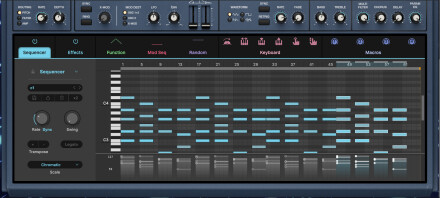
Unfortunately, as on the Jup-8, the “Dual” mode has not been taken up, a habit at Arturia, which deprives us of sequences mixing two distinct timbres.
Finally, on the effects side, a brand-new Trance-Gate, ideal for pulsating textures, enhances the section.
All in all, the Jup-8000 proves to be an excellent surprise and very pleasant to use. It will delight those who wish to bring a Trance or Dance flavor to their productions as much as those who evolve in Chiptune or the Lofi Girl universe, two styles that the Jup-8000 seems to evoke with ease.
Pure LoFi : a virtual instrument dedicated to vintage lo-fi grain
Among the new highlights of this V Collection, one original creation is particularly eye-catching: Pure Lofi. In recent years, we’ve seen a real comeback for this type of imperfect, grainy sound, typical of the cheap samplers of the 80s. Instruments such as Casio SKs or Yamaha VSSs have today won the favor of a whole generation of “bedroom producers” in search of outdated, distorted textures.
On the hardware side, this trend has recently been embodied in machines like Kiviak Instruments’ Wofi, or Sonicware’s Liven LoFi-12, also passed through our hands. Arturia, with this new original virtual instrument—after Pigments and the Augmented series—enters the dance with Pure Lofi. With the aim of offering a simple, inspiring tool capable of bringing that characteristic lo-fi grain to your productions.
As soon as you open Pure Lofi, you’re reassured by its crystal-clear interface and meticulous design, where everything seems perfectly accessible. At the very top, a banner allows you to choose from six coloring algorithms with evocative names: Golden Age, Velvet Frost, Vintage Glow, Dim Memories, Cathodic Tube, and Fuzzy Line. A nice touch: each algorithm is accompanied by a visual representation of a 3.5-inch floppy disk.
A large rotary knob entitled Lofi Amount lets you adjust the intensity of the coloring applied. Note that this section can be deactivated if you wish to work with the sound in a more neutral way.

- 09 – Pure Lofi Surprises02:07
- 10 – Pure Lofi Key Blue Words00:44
- 11 – Pure Lofi Key Et1001:29
- 12 – Pure Lofi Plain01:08
- 13 – Pure Lofi Prel01:14
- 14 – Pure Lofi Dire Nothing01:11
At the center of the interface sit four sections. The first three are devoted to sound generation. The Realistic Instrument and Creative Instrument sections allow you to choose from a bank of samples, which a deterioration algorithm will then process. The first six emulated algorithms reproduce the behavior of old samplers, and some names will immediately speak to connoisseurs: CMI, EMU, SK1, SP1200, Weary900, MPC. The other three, Deteriorate, Damage and Crush, are original Arturia creations.
The last generator, Noise Texturer, lets you add a noise or sound texture. It’s the only generator where you can import your own samples. It does not, however, offer a deterioration algorithm.
The fourth section is dedicated to filtering, with three modes available: Clean Multimode, Analog Multimode and Lofi. The latter has no resonance, but incorporates a Jitter parameter that introduces welcome micro-variations to enrich the rendering.
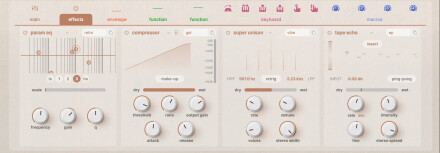
Pure Lofi includes a fine bank of presets: worn synthetic textures, dusty pianos, grainy leads and saturated pads. Each patch skillfully plays with sonic deterioration: blunted transients, blurred layers. We’re reminded of Boards of Canada, J Dilla or the VHS ambience of the '80s. The result is credible, inspiring, and, above all, highly musical.
Pure Lofi is a simple yet formidable tool for injecting character into your productions. Arturia succeeds in offering a fun, immediate instrument with an authentic sound, without falling into the caricature of forced lo-fi. Whether you’re producing chillwave, hip-hop or synthpop, it’s a great companion for getting your sound tastefully dirty.
V Collection 11: other important additions and updates
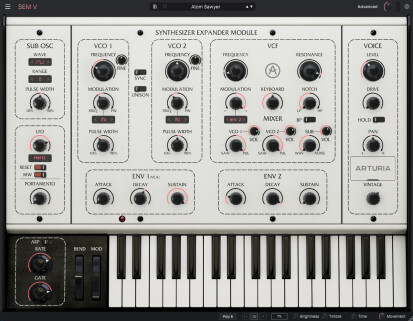
As with other recently updated instruments, we’re delighted to find the now-ubiquitous “Advanced” section, which adds a real plus to the user experience. And good news, the Multi-Arp is back, enabling all manner of rhythmic and melodic experimentation. Once again, this section stands out for its richness and ease of use. Its widespread integration into a growing number of instruments in the V Collection is an excellent idea: it facilitates navigation, promotes common reflexes between instruments, and makes the bundle more coherent in use.
Augmented Mallets expands the Augmented family, without revolutionizing the formula. But with the introduction of version 2 of the Augmented interface (generalized to all instruments in the series), with a few welcome adjustments, for example, direct access to sample selection from the Play page. This provides the user with a clearer and more immediate experience. The engine remains faithful to the concept of the series: an acoustic instrument as a base (here percussion and mallets), enriched by layers of synthesis for a more modern, textural rendering. Versatile, Augmented Mallets lends itself equally well to cinematic, ambient, lo-fi atmospheres… or any other production requiring subtle, expressive color. Ultimately, useful for many things.
As mentioned in the introduction, this update is also accompanied by the integration of former instruments hitherto sold separately: the MiniBrute V, a virtual version of Arturia’s famous analog monosynth; the Synthx V which models an Italian analog polyphonic; and the Augmented Yangtze, featuring hybridized traditional Chinese instruments. These additions, without being presented as novelties, effectively complete the V Collection 11.


